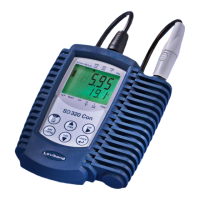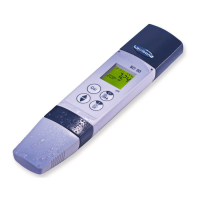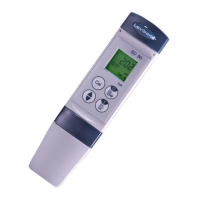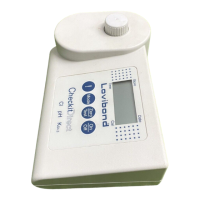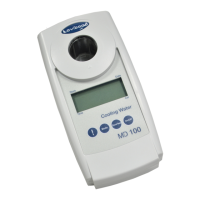Do you have a question about the Lovibond SD 300 pH and is the answer not in the manual?
Defines the purpose and scope of the instrument's application.
Explains the meaning of various safety symbols used in the manual.
Provides essential instructions for safe operation and handling of the instrument.
Lists all items included in the standard package and optional sets.
Provides guidance on battery operation, handling, and USB connection.
Details the various components and indicators on the instrument's display.
Explains the function of each button and key on the instrument.
Describes the available ports for electrodes, sensors, and interface cables.
Explains the handling and function of the device's pop-up clip for mounting.
Explains the concept and factors influencing pH measurement.
Describes the principle and applications of redox potential (ORP) measurement.
Explains how the rH value is calculated and its uses.
Details the process and requirements for calibrating the pH measurement.
Step-by-step guide on how to perform the pH calibration process.
Covers input selection, pH resolution, and calibration settings.
Describes options for selecting standard, DIN, or arbitrary buffer series.
Allows selection between Celsius (°C) and Fahrenheit (°F) for temperature display.
Configuration of automatic measurement hold and instrument auto shut-off.
Settings for the display background lighting, including automatic shut-off.
Settings for serial interface and analogue output, including base address.
Zero correction and slope adjustment for voltage and temperature measurements.
Configuration of measurement and temperature alarms, including thresholds.
Settings for selecting cyclical or single value logger functions.
Setting the instrument's internal clock for time-stamping data.
How to manually save individual measurement points.
How to set up automatic data recording at set intervals.
Procedures for deleting logged data from the instrument.
Details the USB interface for data transfer and connection to PC.
Information on the 0-1V analogue output for external devices.
How to adjust the instrument's measurement inputs for accuracy.
Setting reminders for periodic instrument calibration.
How to retrieve and view stored calibration data.
Guidelines for returning the instrument to the manufacturer.
Instructions for proper disposal of the instrument and batteries.
Details the instrument's connection ports and input impedance.
Information on power consumption, battery type, and auto shut-off.
Details the instrument's compliance with Electromagnetic Compatibility directives.
Defines the purpose and scope of the instrument's application.
Explains the meaning of various safety symbols used in the manual.
Provides essential instructions for safe operation and handling of the instrument.
Lists all items included in the standard package and optional sets.
Provides guidance on battery operation, handling, and USB connection.
Details the various components and indicators on the instrument's display.
Explains the function of each button and key on the instrument.
Describes the available ports for electrodes, sensors, and interface cables.
Explains the handling and function of the device's pop-up clip for mounting.
Explains the concept and factors influencing pH measurement.
Describes the principle and applications of redox potential (ORP) measurement.
Explains how the rH value is calculated and its uses.
Details the process and requirements for calibrating the pH measurement.
Step-by-step guide on how to perform the pH calibration process.
Covers input selection, pH resolution, and calibration settings.
Describes options for selecting standard, DIN, or arbitrary buffer series.
Allows selection between Celsius (°C) and Fahrenheit (°F) for temperature display.
Configuration of automatic measurement hold and instrument auto shut-off.
Settings for the display background lighting, including automatic shut-off.
Settings for serial interface and analogue output, including base address.
Zero correction and slope adjustment for voltage and temperature measurements.
Configuration of measurement and temperature alarms, including thresholds.
Settings for selecting cyclical or single value logger functions.
Setting the instrument's internal clock for time-stamping data.
How to manually save individual measurement points.
How to set up automatic data recording at set intervals.
Procedures for deleting logged data from the instrument.
Details the USB interface for data transfer and connection to PC.
Information on the 0-1V analogue output for external devices.
How to adjust the instrument's measurement inputs for accuracy.
Setting reminders for periodic instrument calibration.
How to retrieve and view stored calibration data.
Guidelines for returning the instrument to the manufacturer.
Instructions for proper disposal of the instrument and batteries.
Details the instrument's connection ports and input impedance.
Information on power consumption, battery type, and auto shut-off.
Details the instrument's compliance with Electromagnetic Compatibility directives.
| Brand | Lovibond |
|---|---|
| Model | SD 300 pH |
| Category | Measuring Instruments |
| Language | English |
